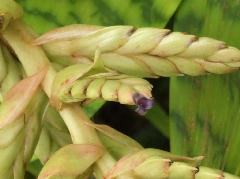
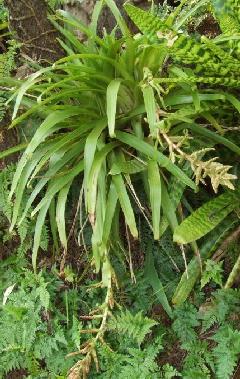
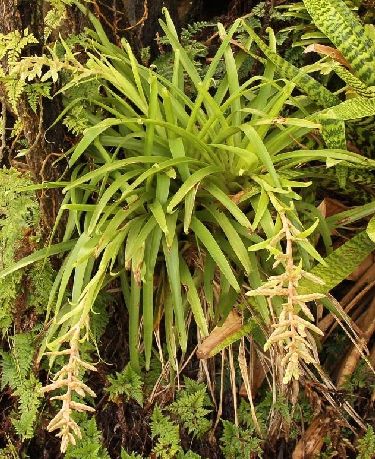
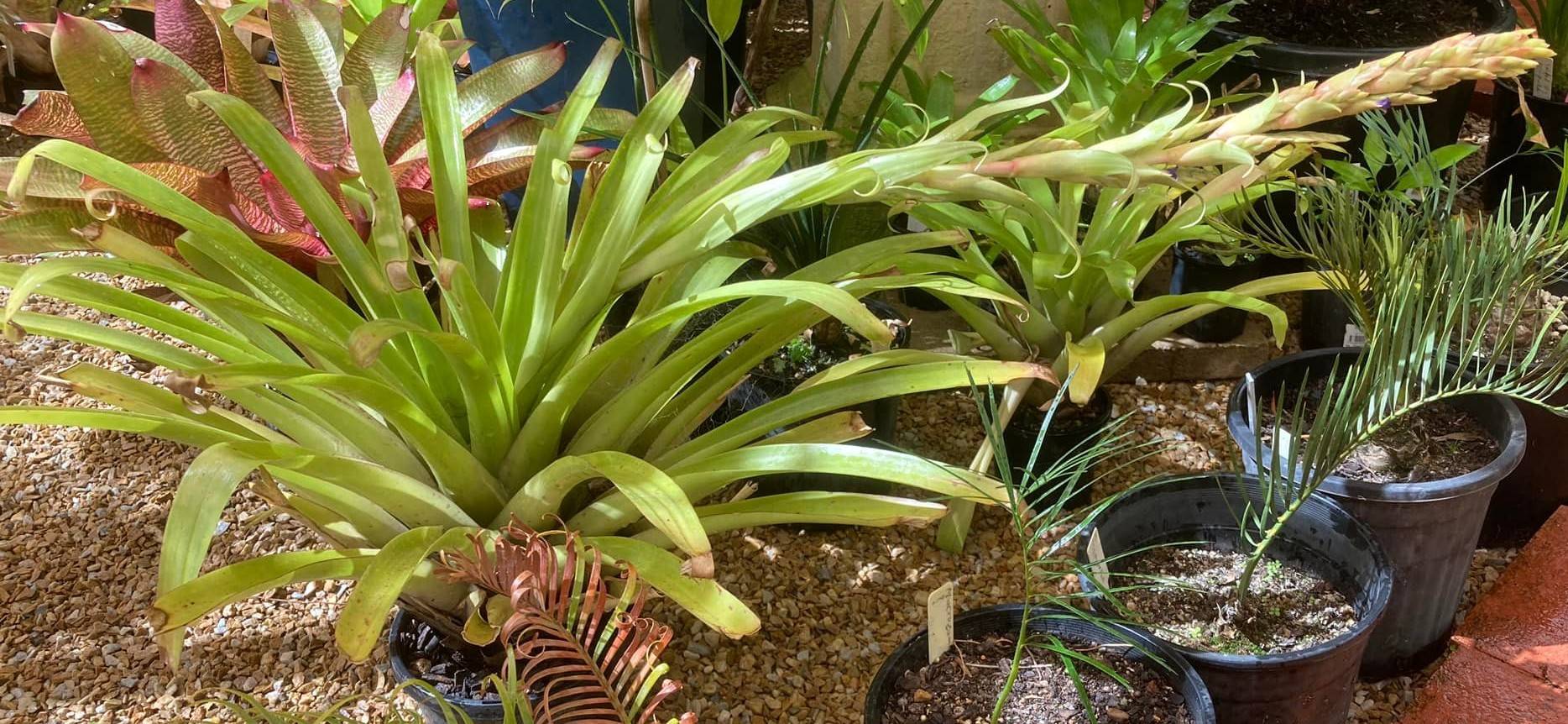
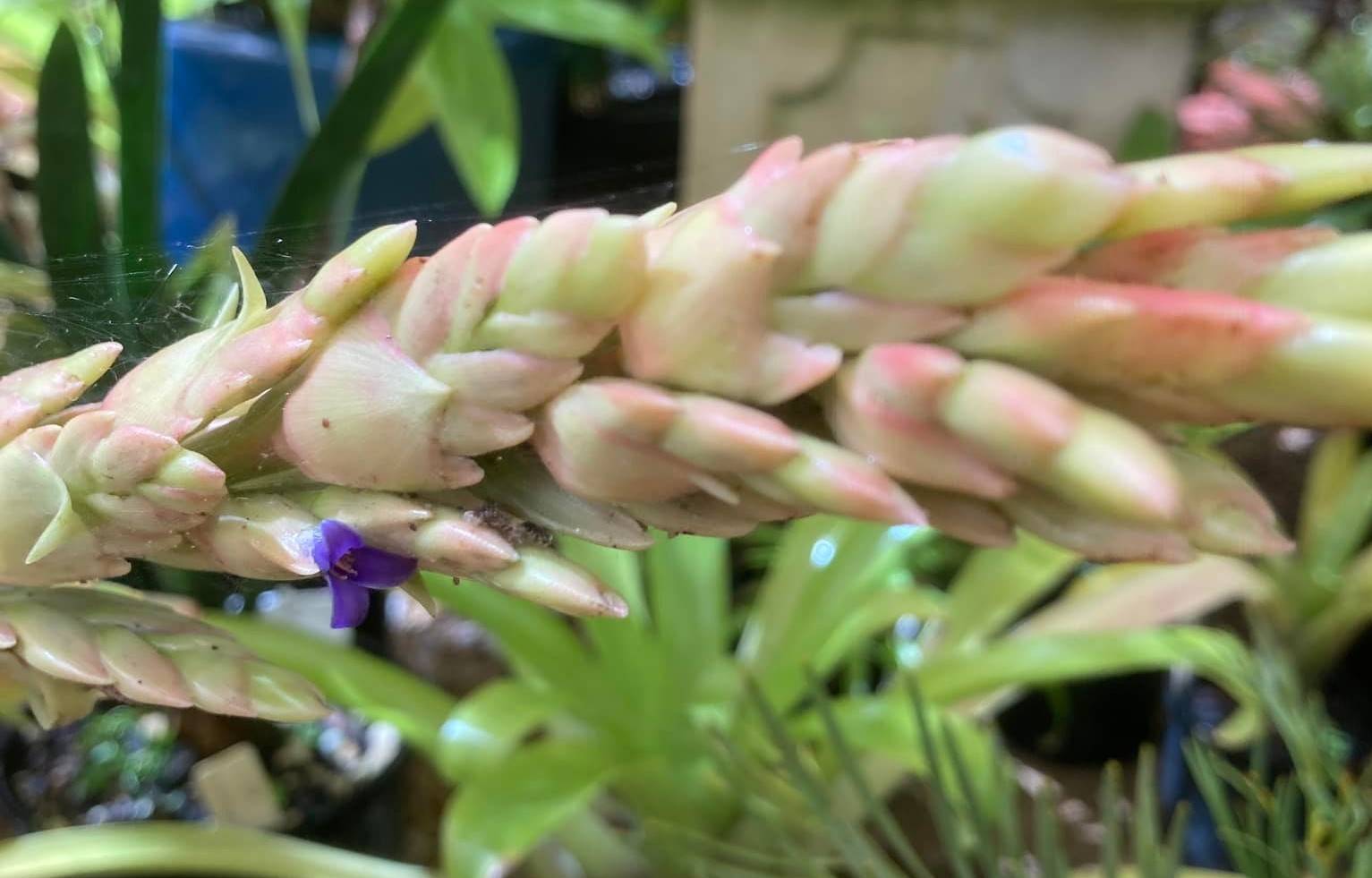
PLANT Stemless, flowering 60-80cm high, leaves numerous, erect, making a rosette 60cm diameter.
LEAF SHEATH Indistinct, thin elliptic, to 16cm long, 6cm wide, inside for 5cm from base dark brown, small appressed scales, then wine red and becoming tiny lepidote spotted, outside shiny aubergine colour, lepidote spotted.
LEAF BLADE 3.5cm wide, above the sheath, to 30cm long tongue shaped, triangular, thin, 1cm tip portion bent outwards, the edges are bent, inside almost glabrous, shiny green with red flecks and spots, outside scaled with very fine spots, green, robustly red flecked, nerved.
SCAPE Erect to 20cm long, round, 8mm diameter, hard woody, red, naked, nerved.
SCAPE BRACTS few, erect, subfoliate, the bottom ones 9cm long, upper ones 6cm long. Internodes 4-5cm. Sheath covers the stem totally for 2cm then the stem is visible, the blade is thinner, the outside is broken acute tipped.
INFLORESCENCE Exceeds the leaves, bipinnate, 25cm high, 8-12cm wide, cylindrical, lax in the lower part, dense near the tip, 18-20 spikes. At the bottom spaced 2cm apart and at an angle of 90º . At the top almost erect, polystichously arranged.
SPIKE 4-5cm long, 2-2.5cm wide, elliptic with 6mm long thick stem, complanate, the smooth side next to the rhachis, 5-8 dense imbricate flowers (the bottom ones occasionally sterile), compound
FLOWER Sessile, erect, overhangs flower bract by 3mm, and with a few spreading petals, very inconspicuous, scentless.
PRIMARY BRACT Shorter than the spike, the bottom ones similar to the stem bracts, sheath oval, 1/2 to 1/3rd as long as the spike, and cupshaped at the bottom, firmly enclosed, the bottom blades acuminate and the outside rolled, those above short and hook tipped, naked, shiny green red, the tip with weak appressed scales
FLOWER BRACT As long as the sepals or 1mm shorter and firmly enclosed, 17-20 (22) mm long, 15-18mm wide, elliptic, tipped, hard leathery with 1mm thickened keel, the edges very thin becoming almost transparent, outside shiny plump-red-green, naked, the tip with small dense appressed trichomes, the tip nerved when dry, smooth side bare, inside light green, with dense brown small trichomes, strongly nerved and covered with a slimy liquid.
SEPALS 15 (-20)mm long, 8-10mm wide, elliptic, acuminate, leathery, however becoming thin, shiny green with red tips, naked, strongly nerved, almost free, the posterior ones strongly and winged keeled.
PETALS 2cm long, 6mm wide, tongue shaped hardly narrowing to the base, forming a tube with spreading tips, nerved, top half blue-¬lilac, bottom white.
STAMENS & STYLE Included in the flower, as long as or shorter than the flower tube. Filament 1.2mm long, 0.6mm wide, white, straight, stamens fixed at the base, 6mm long, 1mm wide, tips tapering, pollen yellow. Style 8mm long, white, thicker than the filaments. Stigma lobes white, very small, erect, papillose.
OVARY whitish, conical, 5mm high, 3mm wide at base.
HABITAT Coina, Province Otuzco, La Libertad, North PERU.
DIFFERS FROM T. rubro-violacea IN THAT
1.- Leaf sheaths twice as narrow.
2.- Shorter spreading spike.
3.- Leathery sepals equally short connate.
4.- Short tongue-like petals, spreading at tip.
Notes
On a trip through North-Peru, that I had 1976 together with three friends, I found in the area near Coina a Tillandsia unknown to me. We were visiting the German Dr. Oswaldo Kauffmann in Trujillo. He had told us of his small hospital in Coina where on spare ground in this area there was a black flowering orchid. My friends, who were Orchid fanciers, could not be held back any longer!. We had to be there, even if the way was bad, we wanted to look for this orchid. Over Otuzco we go towards Coina. We sought the black jewel there long and intensively, as we had originally intended. In Coina, they had run out of petrol, and we were consoled by the fact that the Petrol tanker was coming next day and it did eventually arrive 4 days later!. We did not find the fabulous orchid, (naturally!). This remote area was not quite useless because I found a very interesting Tillandsia there. That was 12 years ago, and since then I have observed it in my collection, compared it with the literature, waited for flowering, etc, etc. I introduce this beautiful plant under its new name to you today.